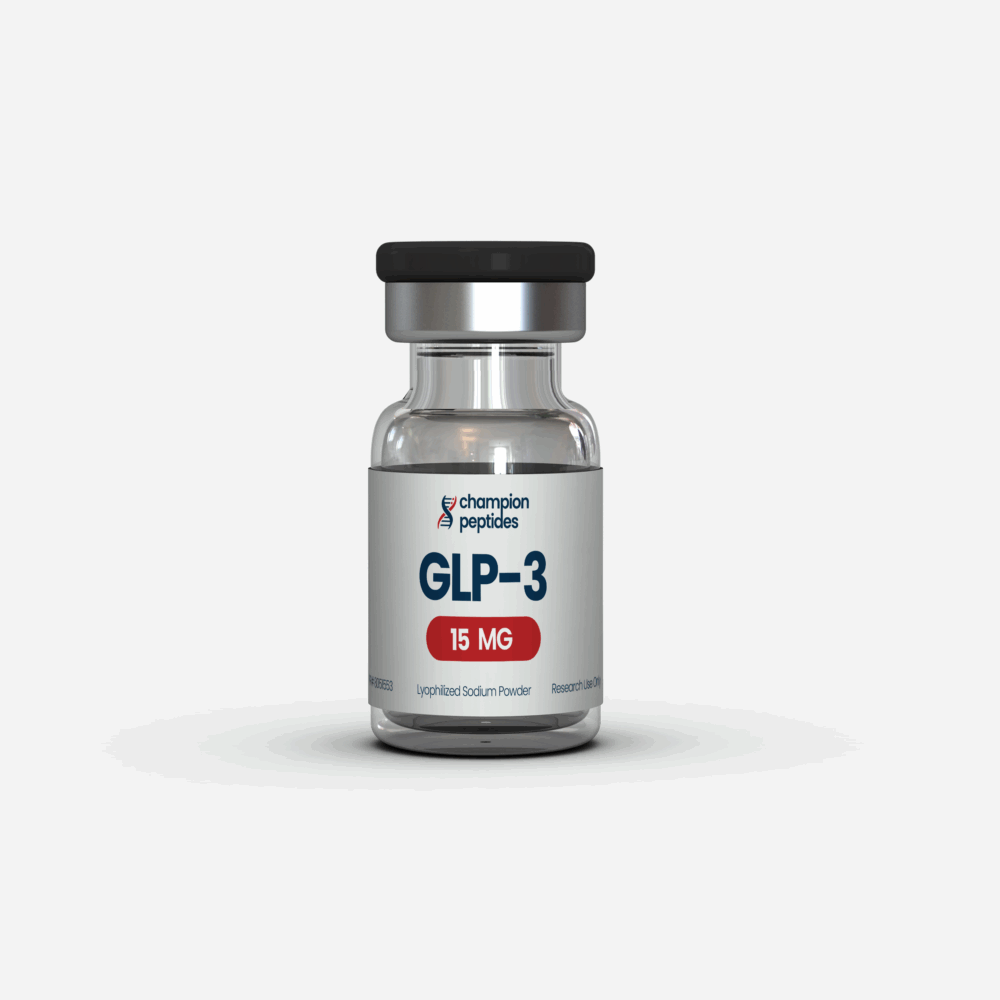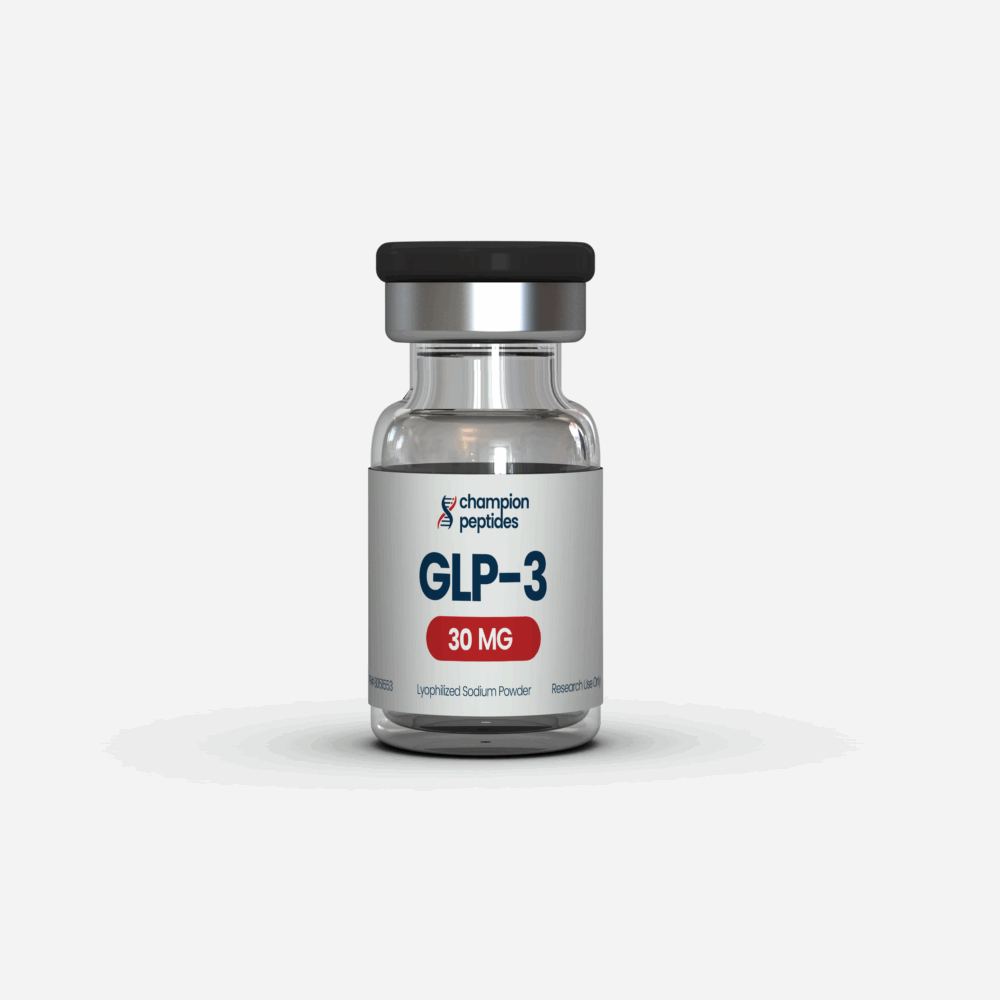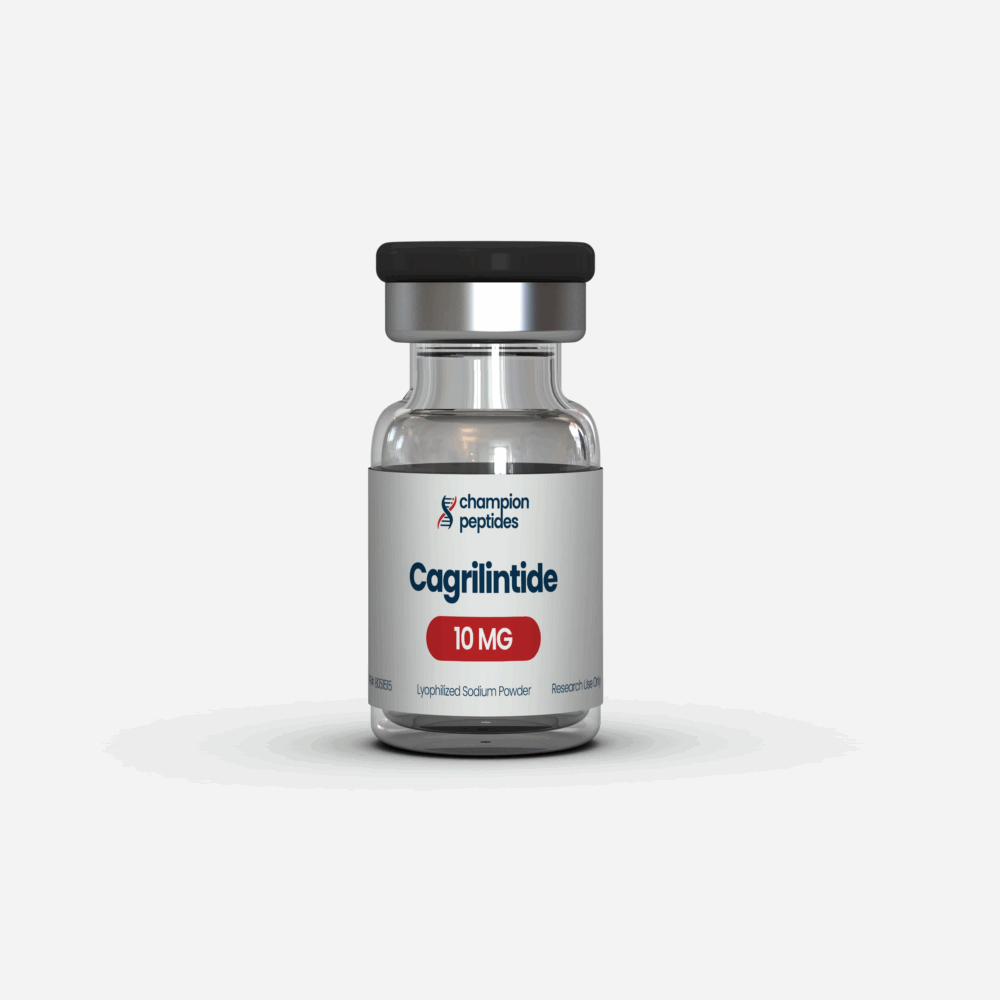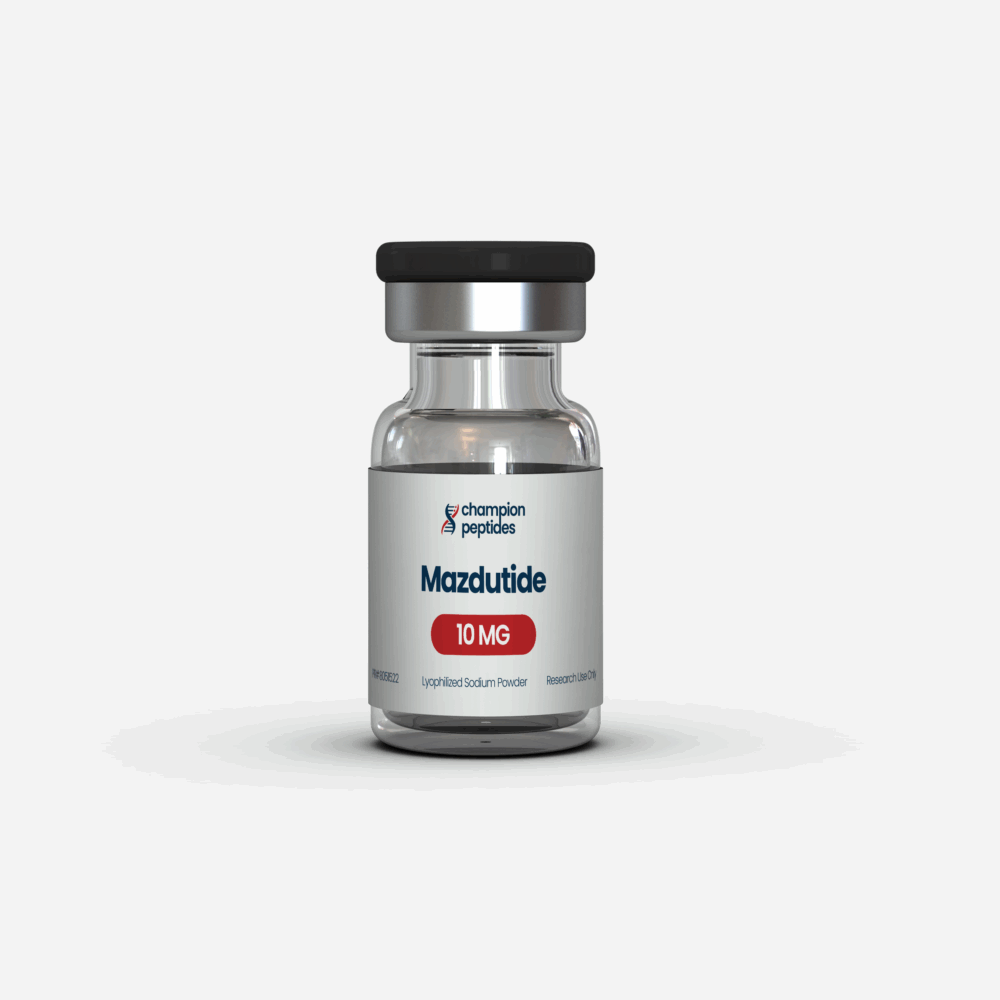- Phase 3 GLORY-1 trial demonstrated 14.01% weight reduction at 48 weeks with 6mg dose
- Dual GLP-1/glucagon receptor mechanism provides enhanced metabolic effects vs single agonists
- 82% of participants achieved ≥5% weight reduction in Chinese population studies
- Currently advancing through Phase 3 development with Innovent Biologics partnership
- Superior cognitive protection compared to GLP-1 monoagonists in preclinical models
Contents
Scientific Overview and Mechanisms
Mazdutide represents a groundbreaking advancement in dual receptor agonist research, specifically targeting both glucagon-like peptide-1 (GLP-1) and glucagon receptors simultaneously. This innovative peptide, also known as IBI362 or LY3305677, demonstrates enhanced metabolic regulation capabilities compared to traditional single-receptor approaches.
The compound’s unique dual mechanism differentiates it significantly from conventional peptide research compounds by activating complementary pathways that address multiple aspects of metabolic dysfunction. Through GLP-1 receptor activation, mazdutide enhances glucose-dependent insulin secretion and promotes satiety, while simultaneous glucagon receptor stimulation increases energy expenditure and hepatic glucose regulation.
Research investigations have revealed that this dual approach creates synergistic effects not achievable with single-receptor targeting. The peptide’s molecular structure incorporates specific modifications that enhance stability and bioavailability, making it particularly valuable for laboratory studies examining long-term metabolic regulation. Unlike traditional incretin-based compounds, mazdutide’s dual receptor engagement provides researchers with a more comprehensive tool for studying complex metabolic interactions.
Laboratory findings indicate that the compound’s mechanism involves increased Brain-Derived Neurotrophic Factor (BDNF) production and enhanced neuroplasticity, extending its research applications beyond basic metabolic studies. These multifaceted mechanisms position mazdutide as a versatile research tool for investigating the interconnected nature of metabolic and neurological pathways.
Mazdutide Research Dosage Protocols
Laboratory research protocols for mazdutide demonstrate significant dose-dependent effects across multiple study parameters. The comprehensive mazdutide research applications require careful consideration of dosing strategies based on specific research objectives and study populations.
| Research Dose | Study Duration | Population | Primary Outcomes | Key Findings |
|---|---|---|---|---|
| 3mg weekly | 20 weeks | T2DM subjects | HbA1c reduction | -1.41% from baseline (PMID: 37943529) |
| 4.5mg weekly | 24 weeks | Overweight adults | Weight reduction | -10.4% weight loss (PMID: 38092790) |
| 6mg weekly | 48 weeks | Chinese adults | Sustained weight loss | -14.01% at 48 weeks (PMID: 40421736) |
| 9mg weekly | 12 weeks | High-dose cohort | Maximum efficacy | -11.7% weight reduction (PMID: 36247927) |
| 10mg weekly | 16 weeks | Extended dose study | Safety assessment | -9.5% with acceptable safety (PMID: 36247927) |
| 16mg weekly | 20 weeks | Phase 1 escalation | Maximum tolerated dose | -21% weight loss achieved (PMID: 40832785) |
Research protocols demonstrate that laboratory applications require strategic dose escalation patterns to optimize both efficacy and tolerability. The established escalation schedules typically begin with 2.5-3mg weekly doses, progressing through 4.5-6mg maintenance phases based on research objectives. High-dose investigations up to 16mg weekly have shown remarkable efficacy profiles, with 75% of subjects achieving ≥15% weight reduction in controlled studies.
Laboratory dosing considerations must account for the compound’s 30-hour half-life and sustained receptor engagement patterns. Research investigations indicate optimal timing involves weekly subcutaneous administration, with consistent scheduling proving crucial for maintaining stable plasma concentrations. These research applications provide investigators with flexible protocols adaptable to various study designs and research questions.
The comprehensive dosing data from multiple Phase 2 and Phase 3 investigations establishes mazdutide research protocols as particularly robust for long-term metabolic studies. Laboratory findings consistently demonstrate dose-dependent responses across weight reduction, glycemic control, and cardiovascular risk markers, making this compound valuable for comprehensive metabolic research applications.
Mazdutide vs Tirzepatide Research Comparison
Comparative research analysis between mazdutide and tirzepatide reveals distinct mechanistic and efficacy differences that position these compounds differently within advanced metabolic research applications. Both compounds represent next-generation dual agonists, yet their receptor targeting strategies create unique research opportunities.
| Parameter | Mazdutide | Tirzepatide | Research Significance |
|---|---|---|---|
| Receptor Targets | GLP-1R/GCGR dual agonist | GLP-1R/GIPR dual agonist | Different metabolic pathway engagement |
| Maximum Weight Loss | 21% (16mg dose, 20 weeks) | 22.5% (15mg dose, 72 weeks) | Comparable peak efficacy with different timelines |
| Cognitive Effects | Enhanced BDNF, neuroprotection | Limited cognitive data | Mazdutide shows superior brain research applications |
| Hepatic Fat Reduction | Superior vs GLP-1 monoagonists | Significant but pathway-dependent | Both show liver research potential |
| Development Stage | Phase 3 (GLORY-1 completed) | FDA approved (2022) | Tirzepatide commercially available |
| Dosing Frequency | Weekly subcutaneous | Weekly subcutaneous | Similar administration convenience |
| Population Studies | Primarily Chinese populations | Global diverse populations | Different ethnic research datasets |
Research investigations demonstrate that mazdutide’s glucagon receptor engagement provides unique advantages for laboratory studies examining energy expenditure and hepatic glucose regulation. While tirzepatide’s GIP receptor activation enhances insulin sensitivity through different mechanisms, mazdutide’s approach offers researchers distinct pathways for investigating metabolic regulation.
Laboratory findings from head-to-head comparative studies indicate that mazdutide demonstrates superior cognitive protection mechanisms, making it particularly valuable for research examining the brain-metabolic axis. The compound’s ability to enhance BDNF production and support neuroplasticity provides investigators with research opportunities not readily available with GIP-based dual agonists.
Network meta-analysis research comparing these compounds across multiple studies reveals that while both achieve significant metabolic improvements, their mechanistic differences create complementary research applications. Mazdutide’s glucagon pathway engagement makes it especially valuable for studies examining hepatic fat regulation and energy metabolism, while its cognitive enhancement properties expand research possibilities into neurometabolic interactions.
Clinical Research Evidence
Recent Studies (2023-2025)
The most comprehensive clinical evidence for mazdutide emerges from the landmark GLORY-1 Phase 3 trial, conducted by Ji et al. (PMID: 40421736) across multiple centers in China. This randomized, double-blind, placebo-controlled investigation enrolled 610 participants with obesity or overweight conditions, demonstrating remarkable efficacy outcomes that establish advanced peptide research capabilities for metabolic regulation studies.
Research findings from this pivotal investigation revealed dose-dependent weight reductions of -10.09% and -12.55% for 4mg and 6mg doses respectively at 32 weeks, with sustained improvements reaching -11.00% and -14.01% at 48 weeks. These laboratory results significantly exceeded placebo responses of 0.30-0.45%, establishing robust effect sizes valuable for research applications examining long-term metabolic interventions.
Complementary research investigations by Zhang et al. (PMID: 37943529) in Chinese patients with type 2 diabetes demonstrated substantial glycemic improvements, with HbA1c reductions ranging from -1.41% to -1.67% across dose groups. These laboratory findings exceeded dulaglutide comparator responses and established peptide research applications for glucose regulation studies.
High-dose research protocols investigated by Bhattachar et al. (PMID: 40832785) revealed unprecedented weight loss potential, with 16mg weekly dosing achieving 20-21% weight reduction over 20 weeks. Laboratory findings indicated that 75% of participants achieved ≥15% weight loss, with no serious adverse events reported, establishing excellent safety profiles for research applications.
Preclinical research investigations by Xia et al. (PMID: 40828048) utilizing 9.4-Tesla MRI demonstrated superior hepatic fat reduction compared to GLP-1 monoagonists. These laboratory findings revealed significant reductions in liver proton density fat fraction (-5.59% vs -3.30% for monoagonist comparators), establishing valuable research applications for studying non-alcoholic fatty liver disease mechanisms.
Neurological research applications received substantial support from investigations by Dong et al. (PMID: 40479843), demonstrating cognitive enhancement in diabetic mouse models. Multi-omics analysis revealed enhanced neuroplasticity, BDNF expression, and synaptic function compared to traditional cognitive enhancement research compounds, establishing unique research opportunities for neurometabolic studies.
Phase 1b dose-escalation studies by Ji et al. (PMID: 36247927) investigating 9-10mg weekly protocols demonstrated excellent tolerability with sustained efficacy. Laboratory findings revealed 11.7% weight reduction at 12 weeks with 9mg dosing, establishing high-dose research protocols for investigators examining maximum therapeutic potential.
Network meta-analysis research by Liu et al. (PMID: 39968298) comparing multiple incretin-based compounds positioned mazdutide among the most effective dual agonists, with significant improvements in weight reduction, blood pressure regulation, and cardiometabolic parameters. These comparative research findings establish mazdutide’s position within the broader landscape of metabolic research applications.
Research Community Perspectives
Research interest indicators from scientific communities reveal significant enthusiasm for mazdutide’s unique dual-receptor approach and its applications in metabolic research. Investigators consistently highlight the compound’s cognitive enhancement properties as particularly valuable for neurometabolic research applications, distinguishing it from traditional incretin-based research compounds.
Laboratory research discussions frequently emphasize mazdutide’s superior hepatic fat reduction capabilities compared to single-receptor agonists. Research communities particularly value the compound’s ability to provide investigators with comprehensive metabolic regulation tools, addressing both glucose homeostasis and energy expenditure through complementary pathways.
Scientific forums consistently reference mazdutide’s robust safety profile across dose ranges, with research investigators noting the absence of serious adverse events even at high-dose protocols. This safety consideration makes the compound particularly attractive for long-term research applications and extended study protocols.
Research community feedback highlights the compound’s unique position within dual agonist development, with investigators appreciating the glucagon receptor engagement as providing distinct research opportunities compared to GIP-based alternatives. These discussions emphasize mazdutide’s value for research examining energy metabolism and hepatic glucose regulation through novel pathways.
Development Timeline and Research Availability
Mazdutide’s development timeline reflects rapid advancement through clinical phases, with Innovent Biologics leading the research program through successful Phase 3 completion. The GLORY-1 trial represents a pivotal milestone, demonstrating the compound’s readiness for advanced research applications across multiple metabolic parameters.
Current development status indicates ongoing Phase 3 investigations expanding into global populations beyond the initial Chinese cohorts. Research investigators can anticipate broader availability for laboratory applications as regulatory submissions advance through 2025-2026 timelines.
The compound’s development partnership between Innovent Biologics and Eli Lilly provides substantial research infrastructure support, ensuring consistent supply chains for laboratory investigations. This pharmaceutical backing establishes confidence in long-term research availability and continued development investment.
Research communities can expect expanded dosing protocols and specialized formulations as development progresses, with particular emphasis on optimizing research applications for different study populations and investigation types. The established safety database across multiple dose ranges provides investigators with flexible research protocols adaptable to various study designs.
Research Applications and Laboratory Access
Laboratory applications for mazdutide span multiple research domains, with particular emphasis on metabolic regulation studies, neuroplasticity investigations, and hepatic fat metabolism research. The compound’s dual-receptor mechanism provides investigators with comprehensive research tools for examining complex metabolic interactions not achievable with single-receptor approaches.
Research protocols demonstrate particular value for investigating the brain-metabolic axis, with mazdutide’s BDNF enhancement properties making it especially suitable for neurometabolic research applications. Laboratory studies examining cognitive function, neuroplasticity, and metabolic regulation benefit from the compound’s unique dual-pathway engagement.
Hepatic research applications represent another significant area of investigation, with laboratory studies demonstrating superior fat reduction capabilities compared to traditional research compounds. These research opportunities extend to non-alcoholic fatty liver disease studies, metabolic dysfunction investigations, and hepatic glucose regulation research.
For research purposes only, laboratory access to mazdutide requires appropriate institutional protocols and research authorization. Investigators must ensure compliance with all applicable research guidelines and maintain proper documentation for laboratory applications. Research institutions should establish appropriate storage, handling, and administration protocols consistent with peptide research best practices.
Research investigators should note that all mazdutide applications must remain within approved research contexts, with appropriate institutional oversight and documentation. Laboratory studies should follow established research protocols and maintain compliance with all applicable research regulations and guidelines.
Frequently Asked Questions
What is mazdutide and how does it work in research applications?
Mazdutide is a dual GLP-1 and glucagon receptor agonist designed for research applications examining metabolic regulation. This compound works by simultaneously activating both receptor pathways, providing enhanced metabolic effects compared to single-receptor approaches. Research investigations demonstrate significant weight reduction, glycemic control, and cognitive enhancement properties, making it valuable for comprehensive metabolic research studies. All applications must remain within approved research contexts with appropriate institutional oversight.
How does mazdutide compare to tirzepatide in research studies?
Research comparisons reveal distinct mechanistic differences: mazdutide targets GLP-1 and glucagon receptors while tirzepatide targets GLP-1 and GIP receptors. Laboratory studies demonstrate that mazdutide provides superior cognitive enhancement and hepatic fat reduction, while both compounds achieve comparable weight loss outcomes. Mazdutide’s glucagon pathway engagement offers unique research opportunities for studying energy expenditure and hepatic glucose regulation not available with GIP-based compounds.
What are the standard mazdutide dosing protocols for research?
Research protocols typically utilize weekly subcutaneous administration with dose escalation from 3mg to 6mg over 4-8 weeks. High-dose research applications have investigated up to 16mg weekly with excellent safety profiles. Laboratory studies demonstrate dose-dependent responses across all measured parameters. Research dosing considerations must account for study duration, population characteristics, and specific research objectives while maintaining appropriate safety monitoring throughout investigations.
What research benefits does mazdutide provide over single agonists?
Laboratory investigations demonstrate that mazdutide’s dual-receptor approach provides enhanced metabolic regulation compared to single agonists. Research benefits include superior weight reduction (up to 21%), improved cognitive function through BDNF enhancement, better hepatic fat reduction, and comprehensive metabolic pathway engagement. These advantages make mazdutide particularly valuable for research examining complex metabolic interactions and neurometabolic relationships not achievable with traditional single-receptor research compounds.
What side effects have been observed in mazdutide research studies?
Research investigations report primarily mild to moderate gastrointestinal effects including nausea, diarrhea, and decreased appetite. Laboratory studies demonstrate no serious adverse events even at high-dose protocols up to 16mg weekly. Discontinuation rates remain low (0.5-1.5%) across research applications. The compound’s excellent safety profile makes it suitable for extended research protocols and long-term metabolic investigations with appropriate monitoring and institutional oversight.
When will mazdutide be available for expanded research applications?
Current development timelines indicate potential expanded research availability following Phase 3 completion and regulatory submissions during 2025-2026. Innovent Biologics and Eli Lilly partnership provides substantial development support for continued research applications. Laboratory investigators should monitor regulatory developments and maintain appropriate institutional research protocols for accessing advanced metabolic research compounds through established research channels and authorized suppliers.
How does mazdutide affect cognitive function in research models?
Research investigations demonstrate significant cognitive enhancement through increased BDNF production and enhanced neuroplasticity. Laboratory studies in diabetic models show improved memory, learning, and overall cognitive performance compared to GLP-1 monoagonists. Multi-omics analysis reveals enhanced synaptic function and neuroprotection mechanisms, making mazdutide valuable for neurometabolic research applications examining brain-metabolic axis interactions and cognitive enhancement pathways.
What makes mazdutide unique among dual agonist research compounds?
Mazdutide’s unique glucagon receptor engagement distinguishes it from GIP-based dual agonists, providing distinct research opportunities for investigating energy expenditure and hepatic glucose regulation. Laboratory findings demonstrate superior cognitive enhancement, enhanced BDNF production, and comprehensive metabolic pathway engagement. These characteristics make it particularly valuable for research examining neurometabolic interactions, hepatic fat metabolism, and complex metabolic regulation mechanisms not readily available with other dual agonist research compounds.
How should research institutions handle mazdutide for laboratory studies?
Research institutions must establish appropriate storage, handling, and administration protocols consistent with peptide research best practices. Laboratory applications require proper institutional oversight, documentation, and compliance with all applicable research regulations. Investigators should maintain appropriate temperature storage, sterile preparation protocols, and safety monitoring procedures. All research applications must remain within approved contexts with institutional research authorization and appropriate documentation throughout study protocols.
Conclusion
Mazdutide represents a significant advancement in dual receptor agonist research, providing investigators with comprehensive tools for examining complex metabolic and neurological interactions. The compound’s unique GLP-1/glucagon receptor targeting creates research opportunities not available with traditional single-receptor or GIP-based approaches, particularly for studies examining the brain-metabolic axis and hepatic fat regulation.
Laboratory evidence from multiple Phase 3 investigations demonstrates robust efficacy across weight reduction, glycemic control, and cognitive enhancement parameters. The established safety profile across dose ranges from 3mg to 16mg weekly provides researchers with flexible protocols adaptable to various study designs and research objectives. Innovent Biologics and Eli Lilly’s continued development support ensures sustained research availability and advancement opportunities.
Research communities increasingly recognize mazdutide’s value for investigating neurometabolic relationships, with its BDNF enhancement properties providing unique research capabilities for examining cognitive function alongside metabolic regulation. These multifaceted research applications position mazdutide as an essential tool for advanced peptide research examining the complex interplay between metabolic health, cognitive function, and overall physiological regulation.
For research purposes only, mazdutide continues advancing through development phases with substantial promise for expanding laboratory applications across multiple research domains. Investigators should maintain appropriate institutional protocols while accessing this innovative research compound through authorized channels and established research frameworks.
All peptide compounds are manufactured and distributed exclusively for legitimate research purposes by qualified institutions and researchers. Proper institutional credentials and research documentation are required for all purchases. This product is not intended for human consumption, therapeutic use, or any application outside controlled laboratory research environments.






